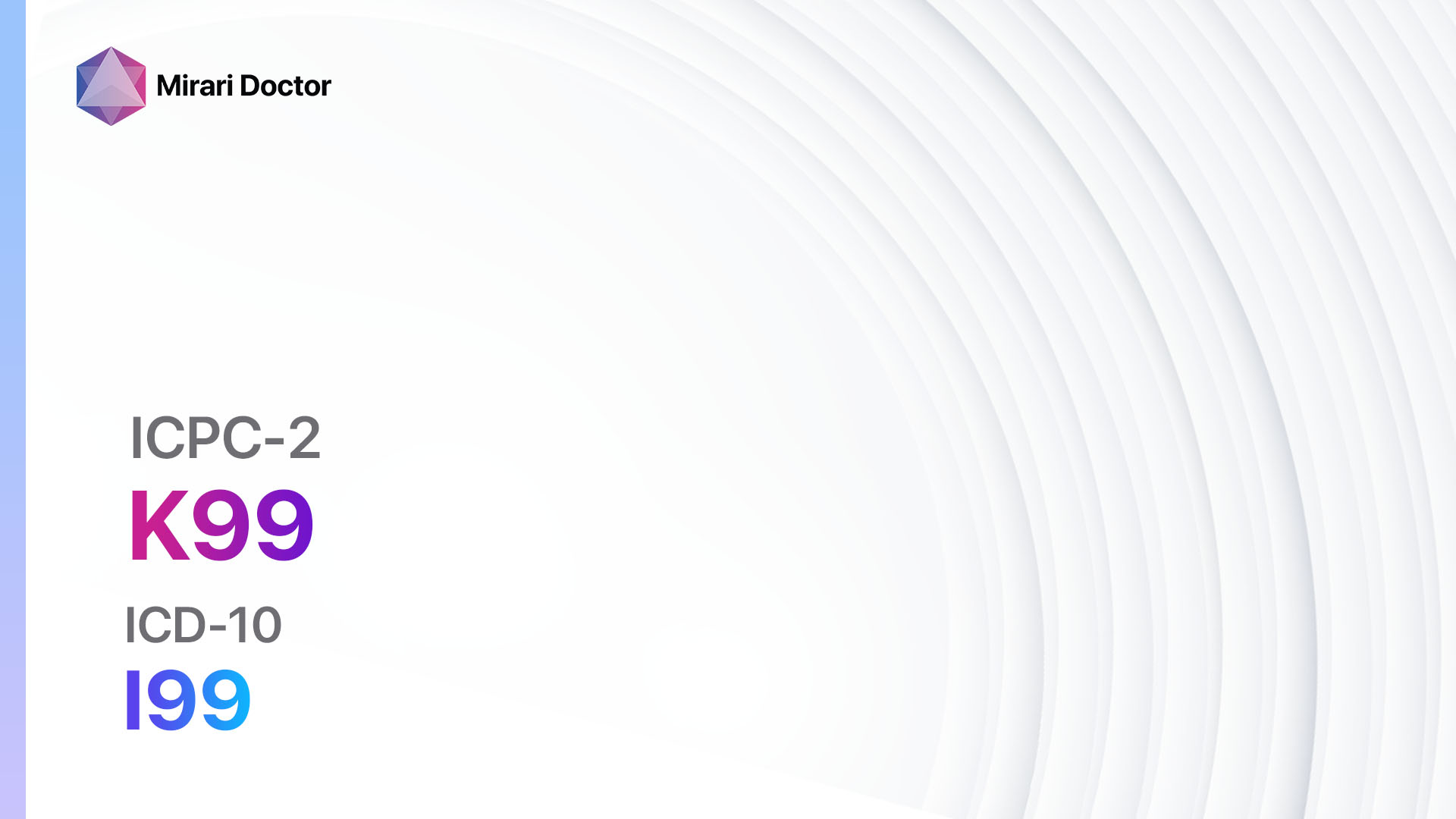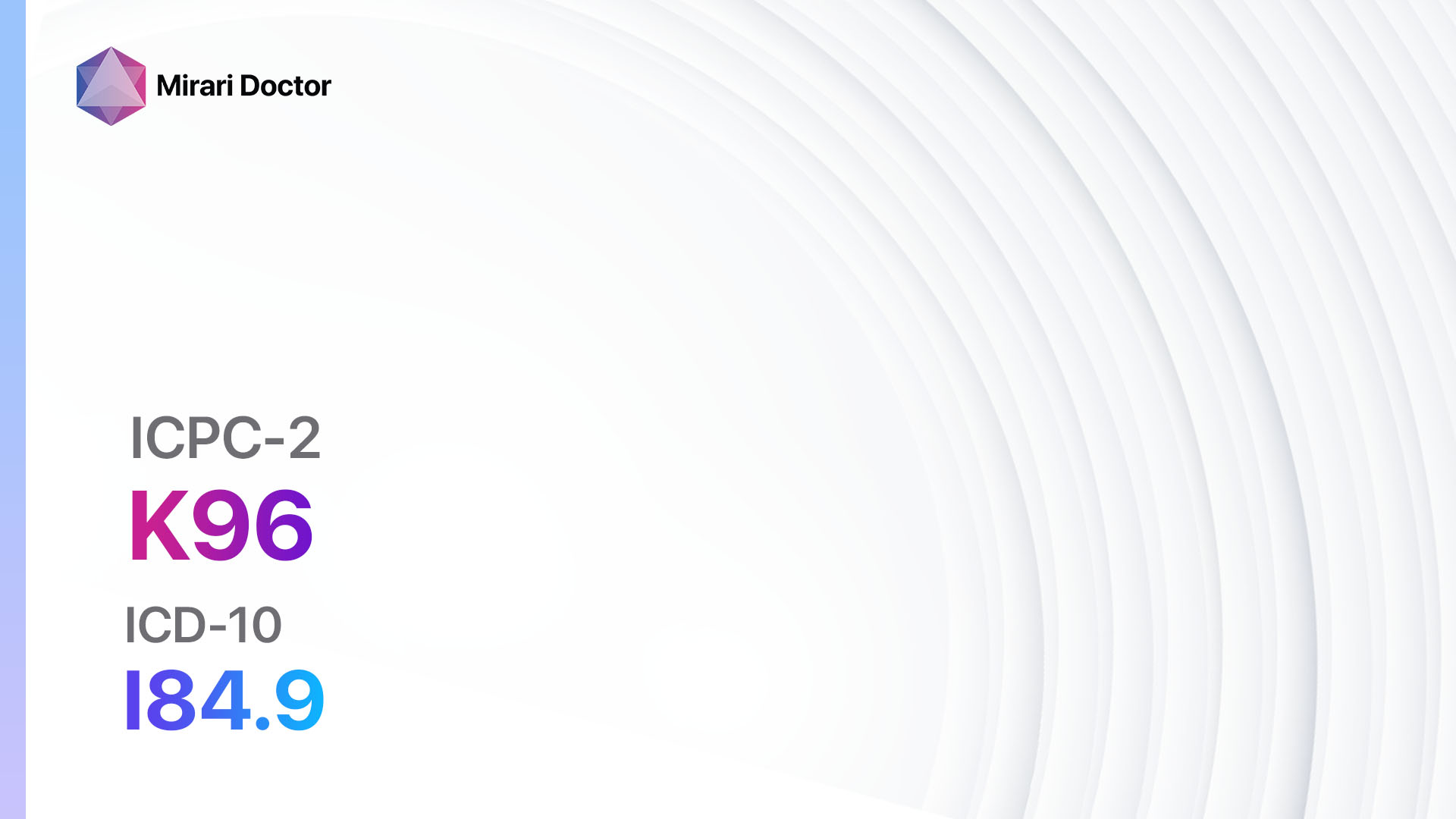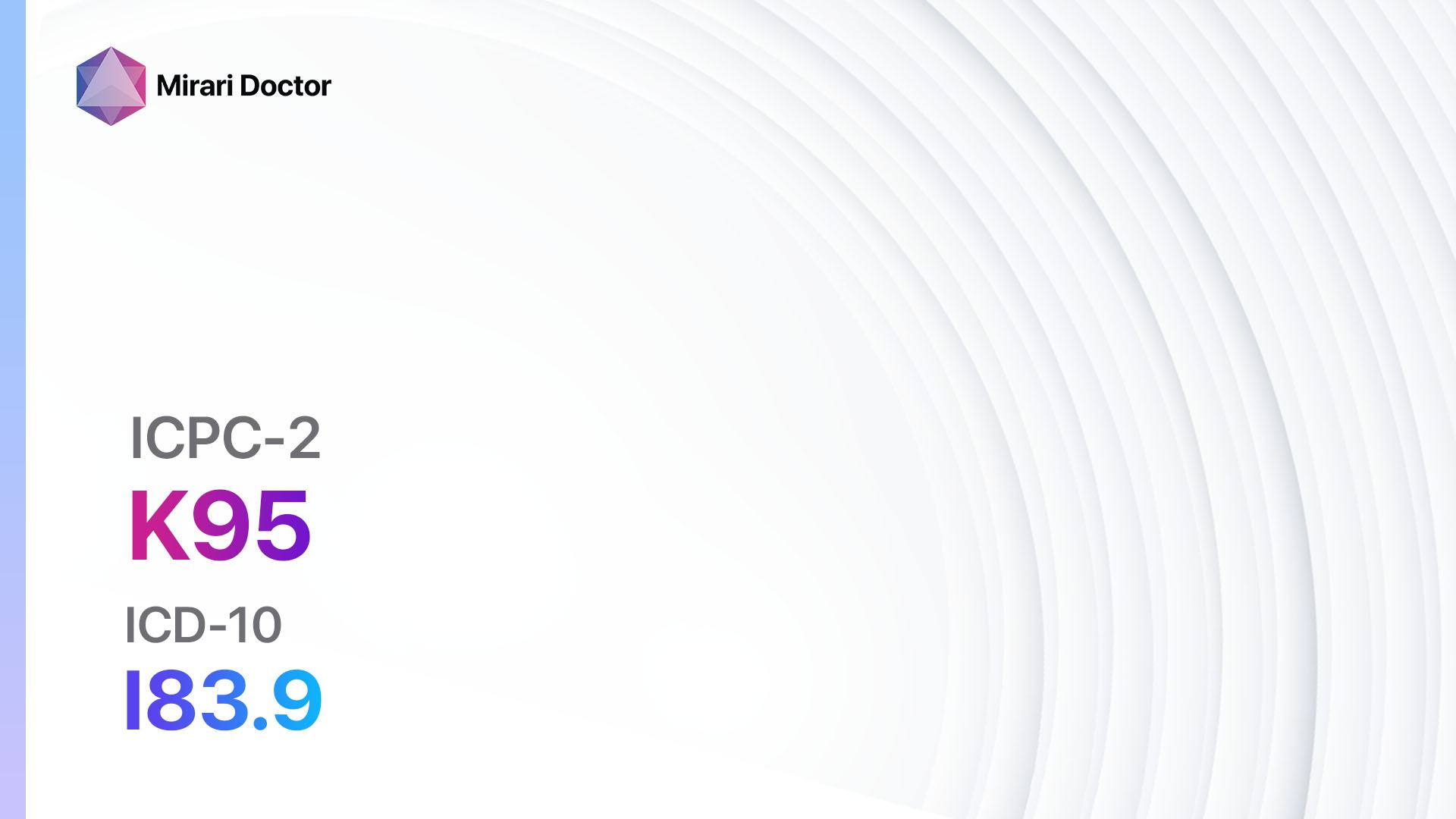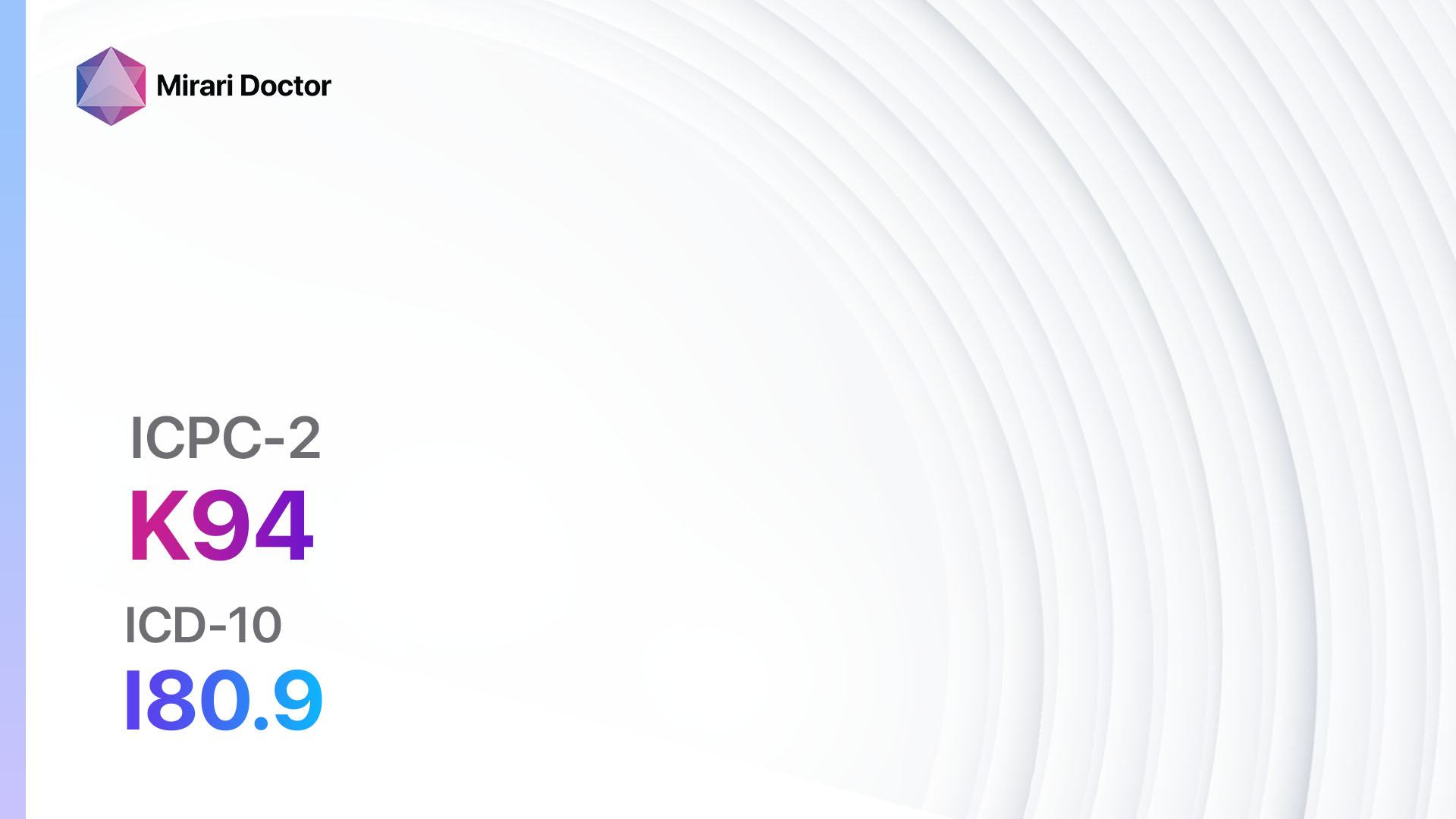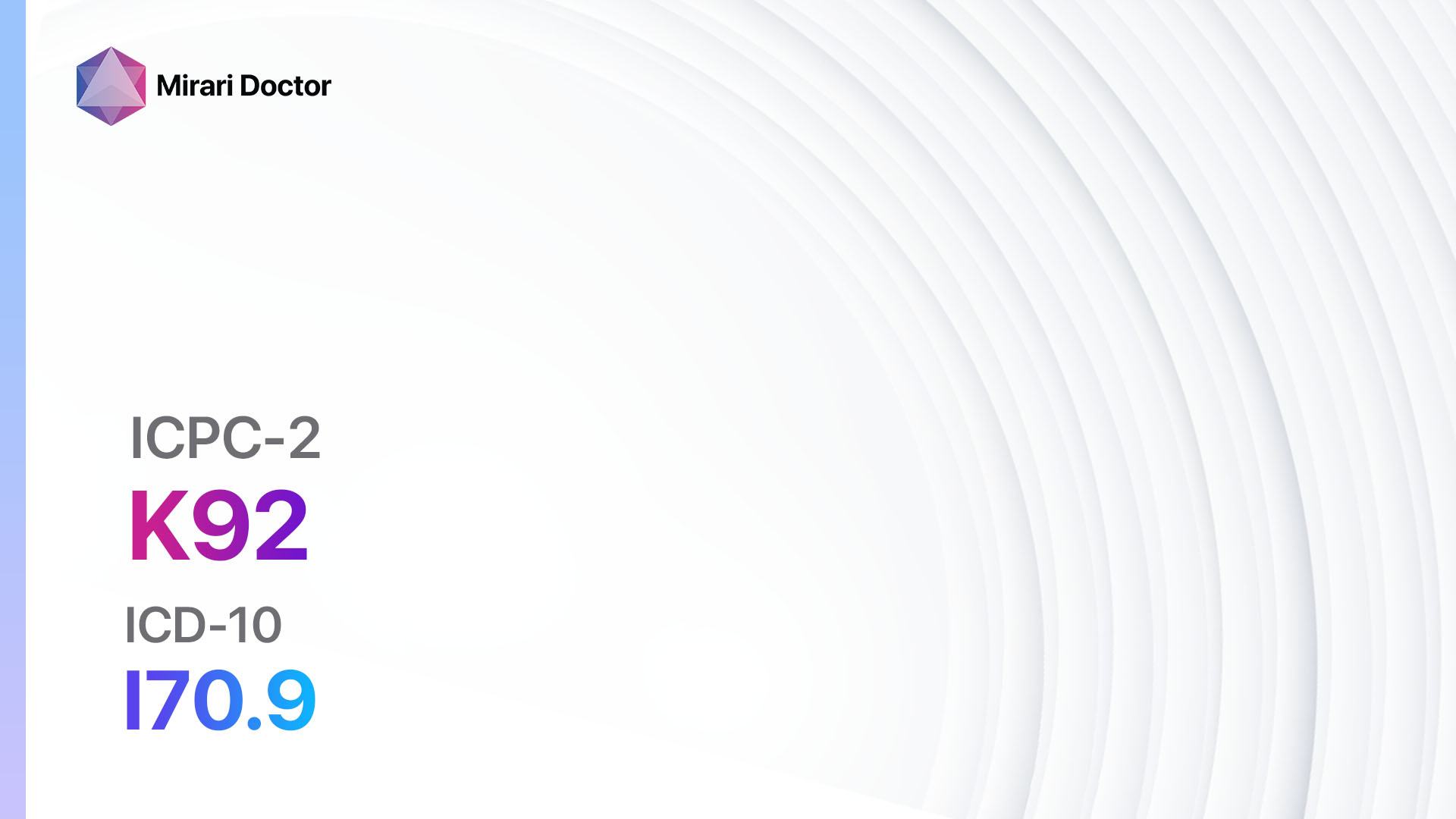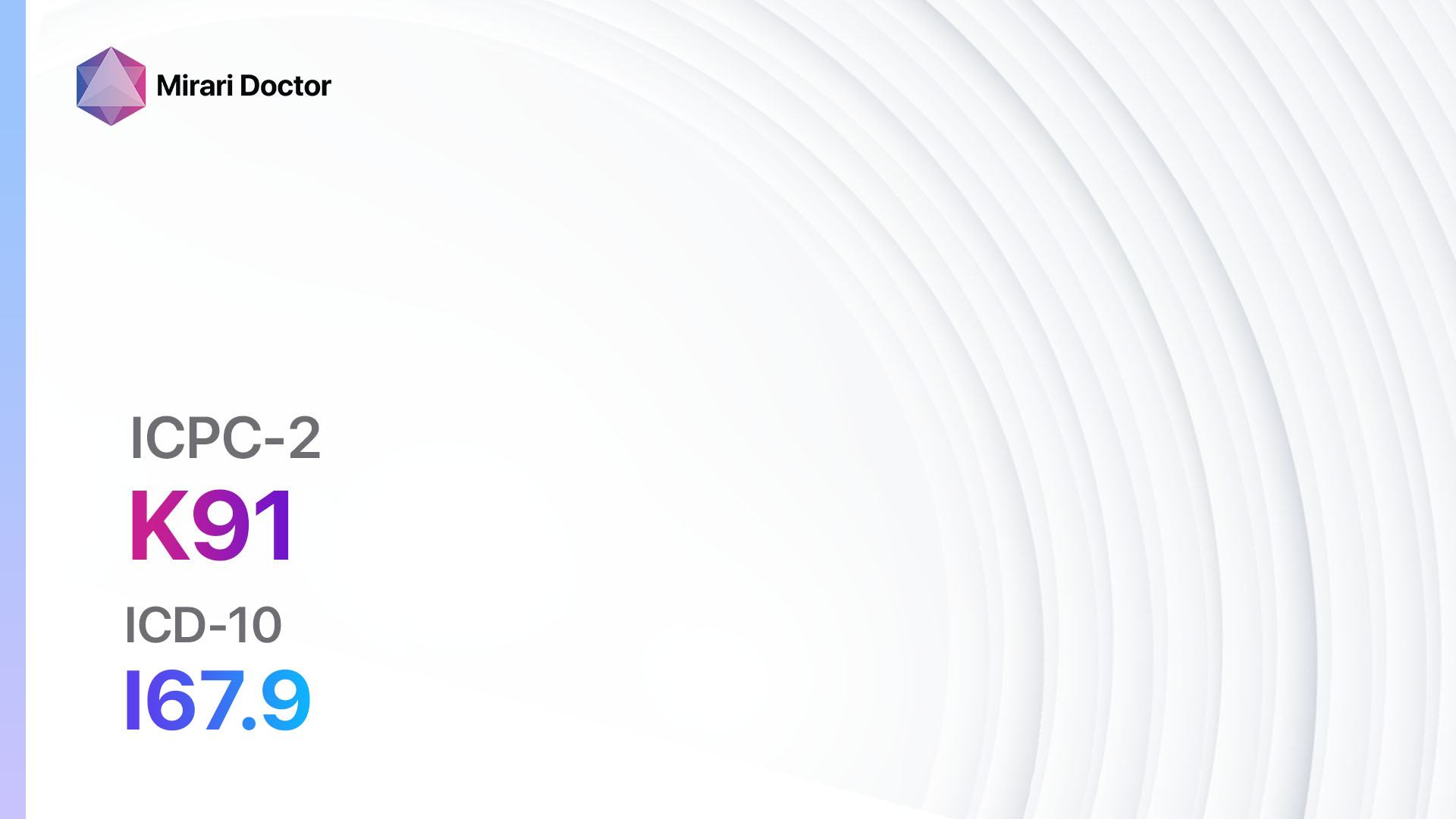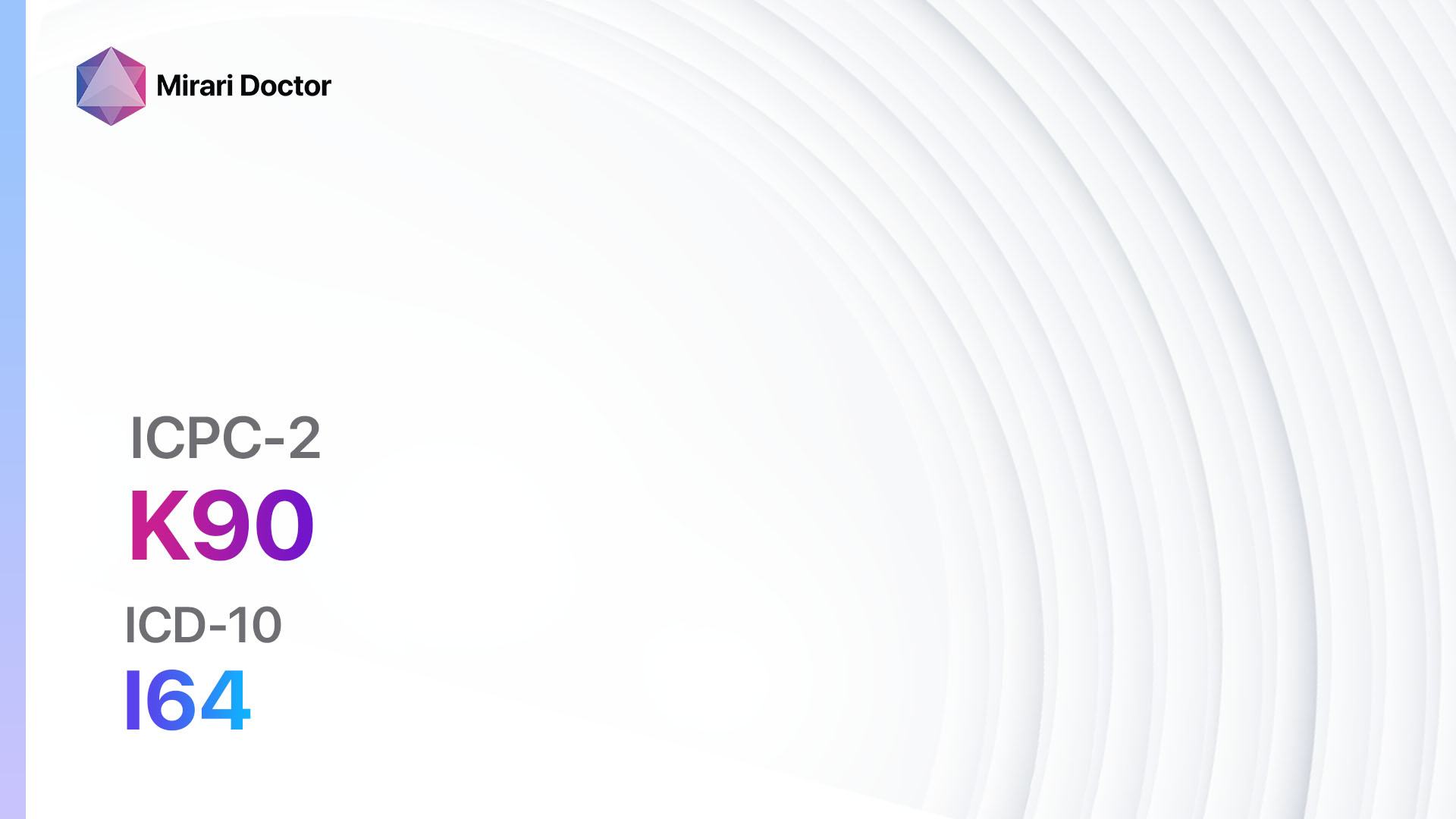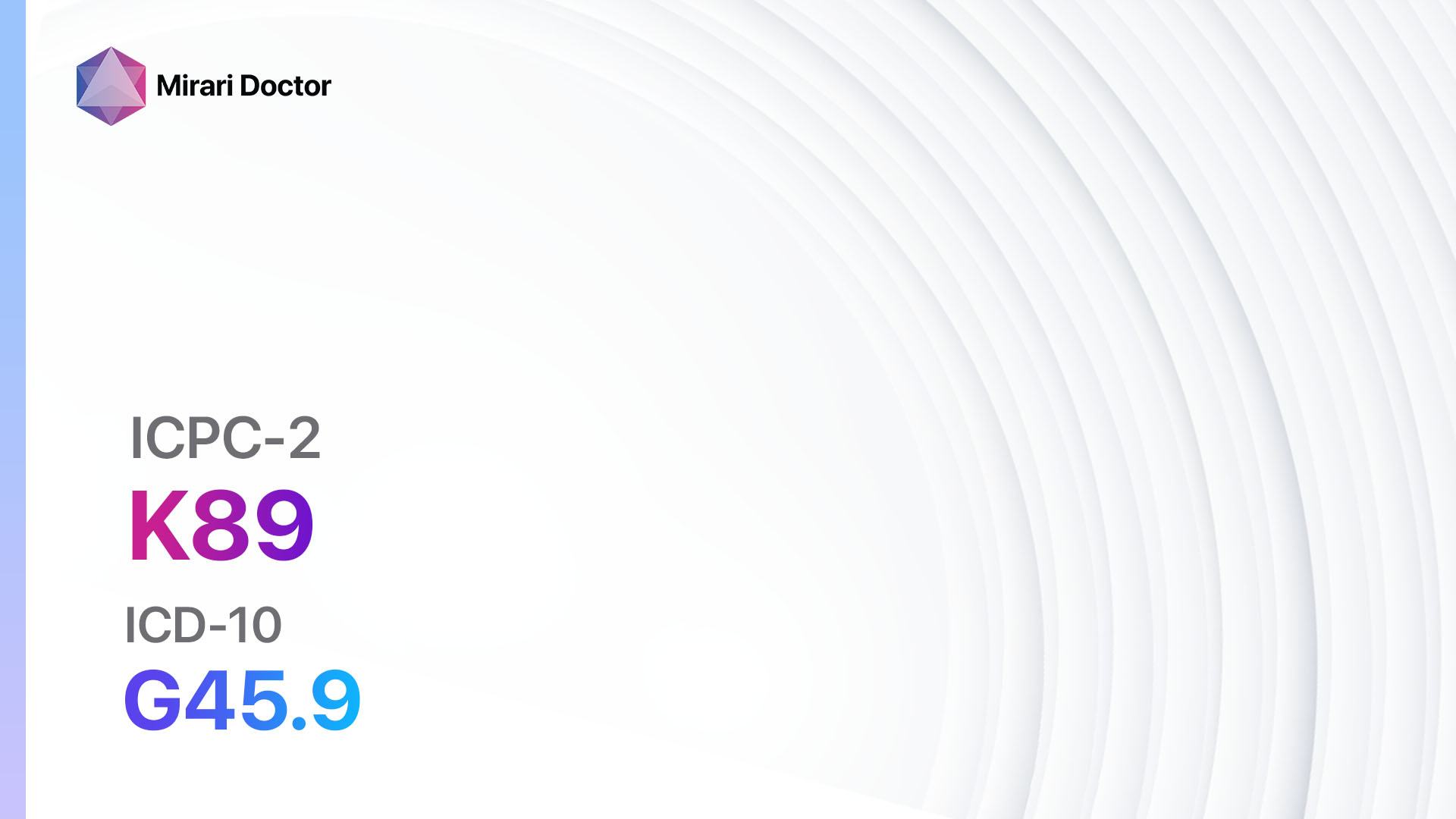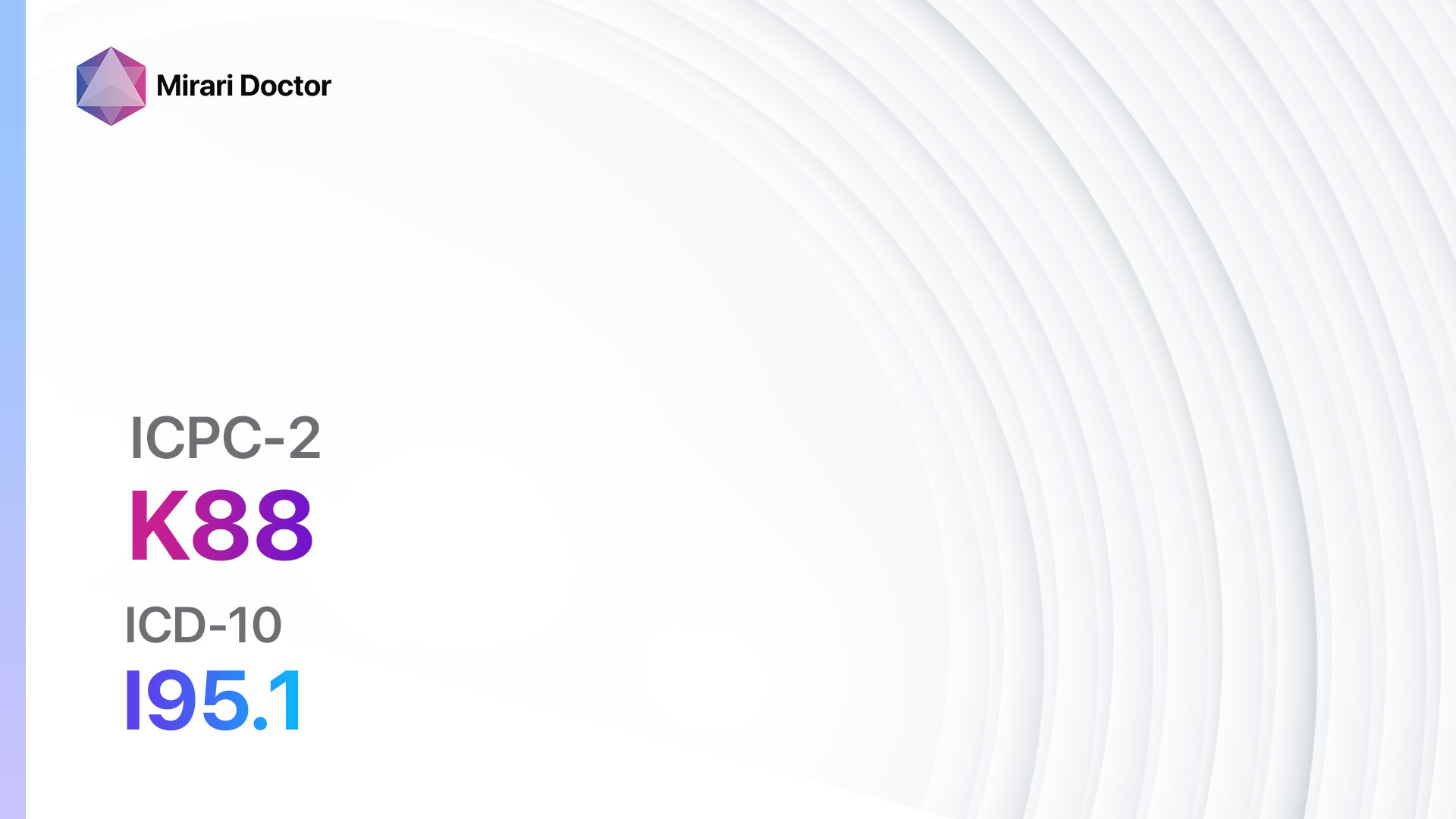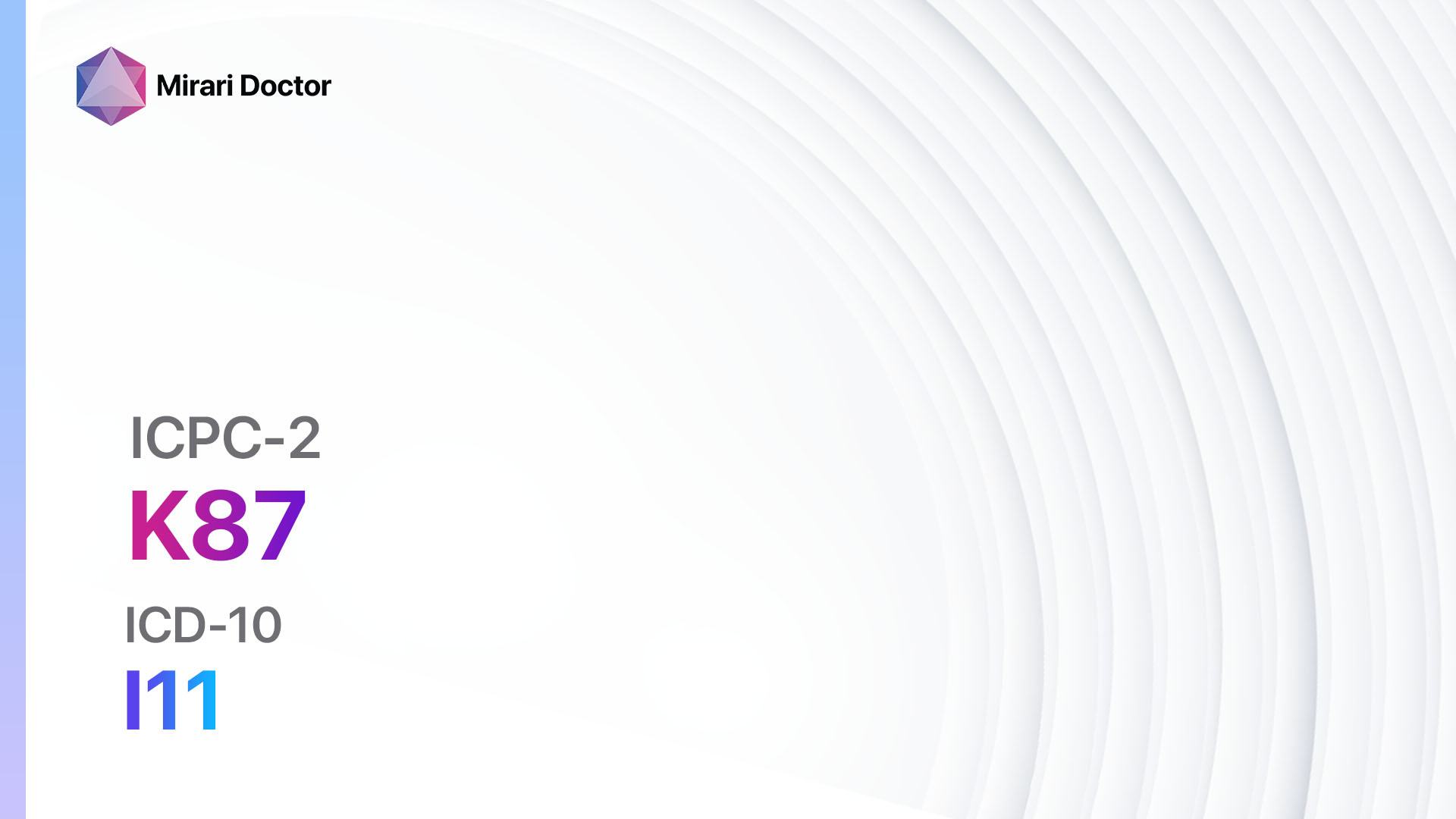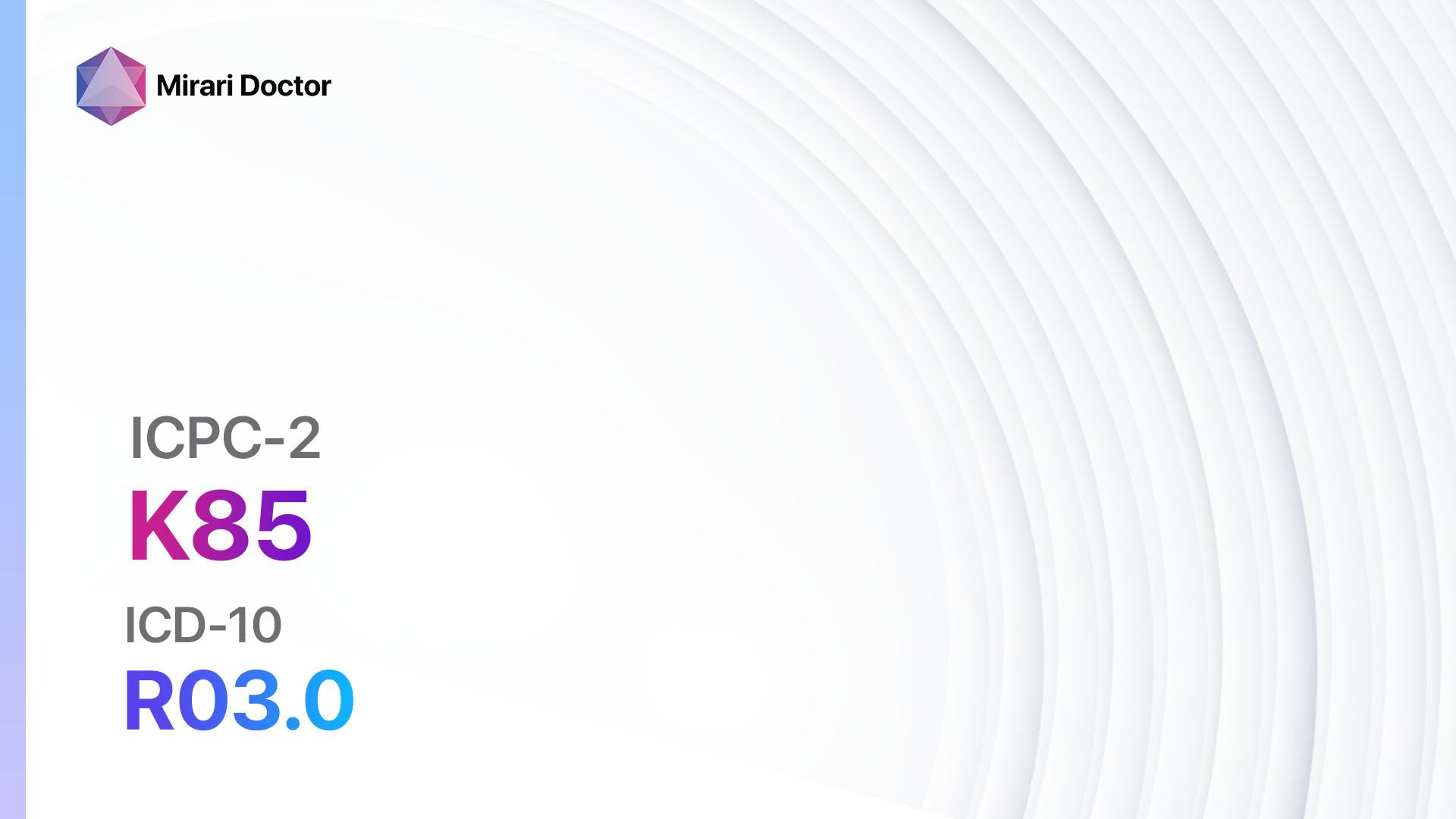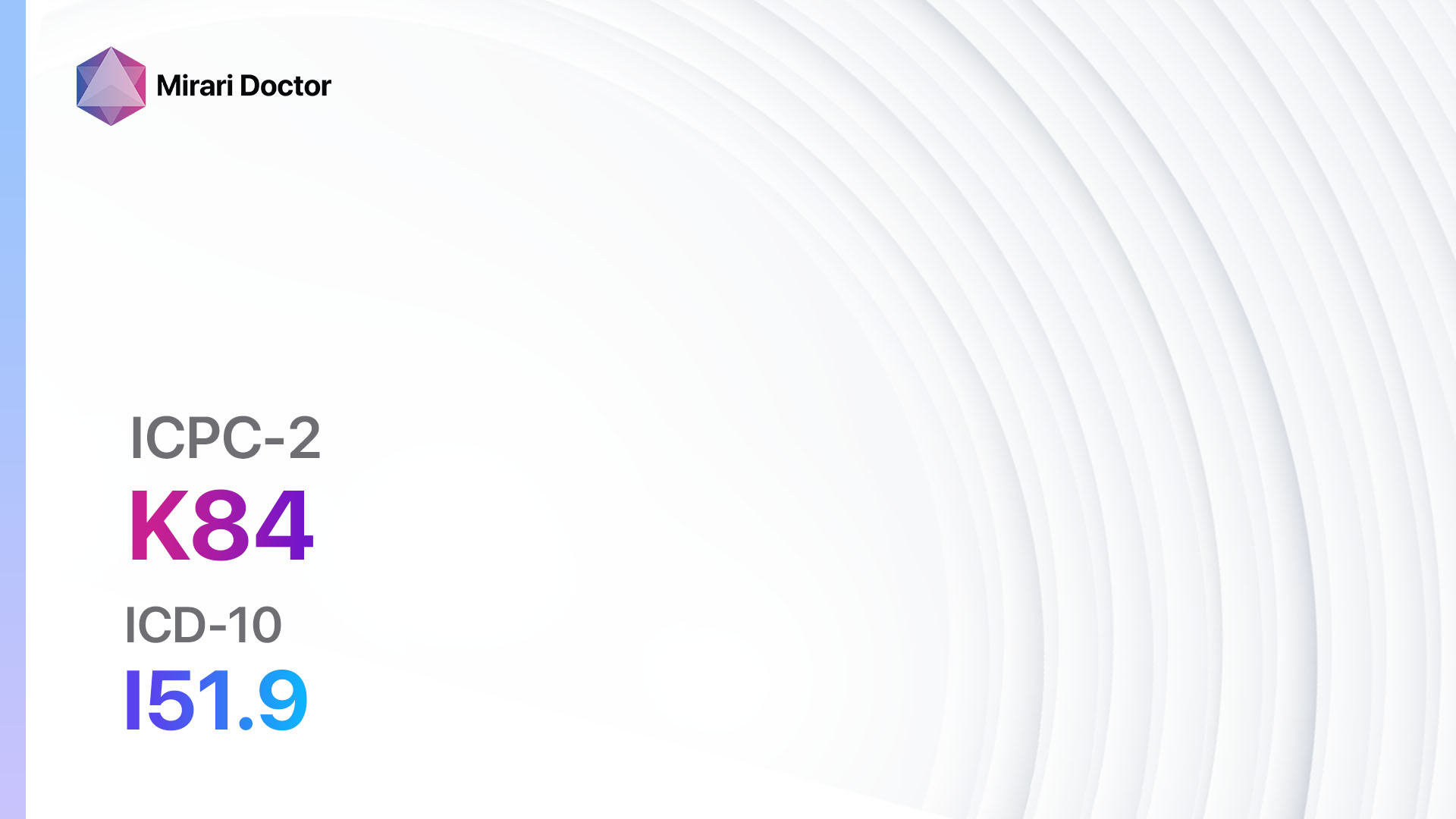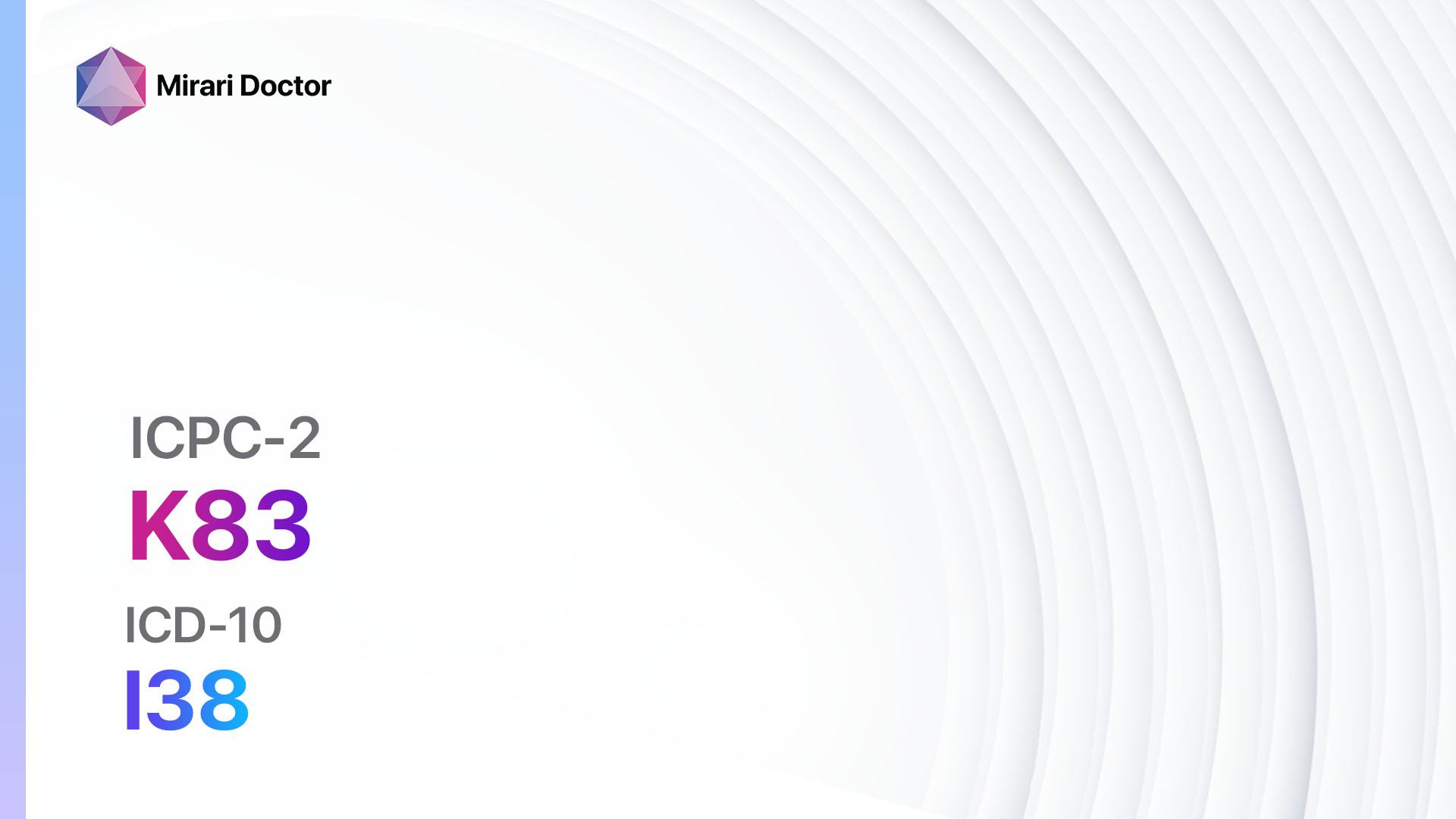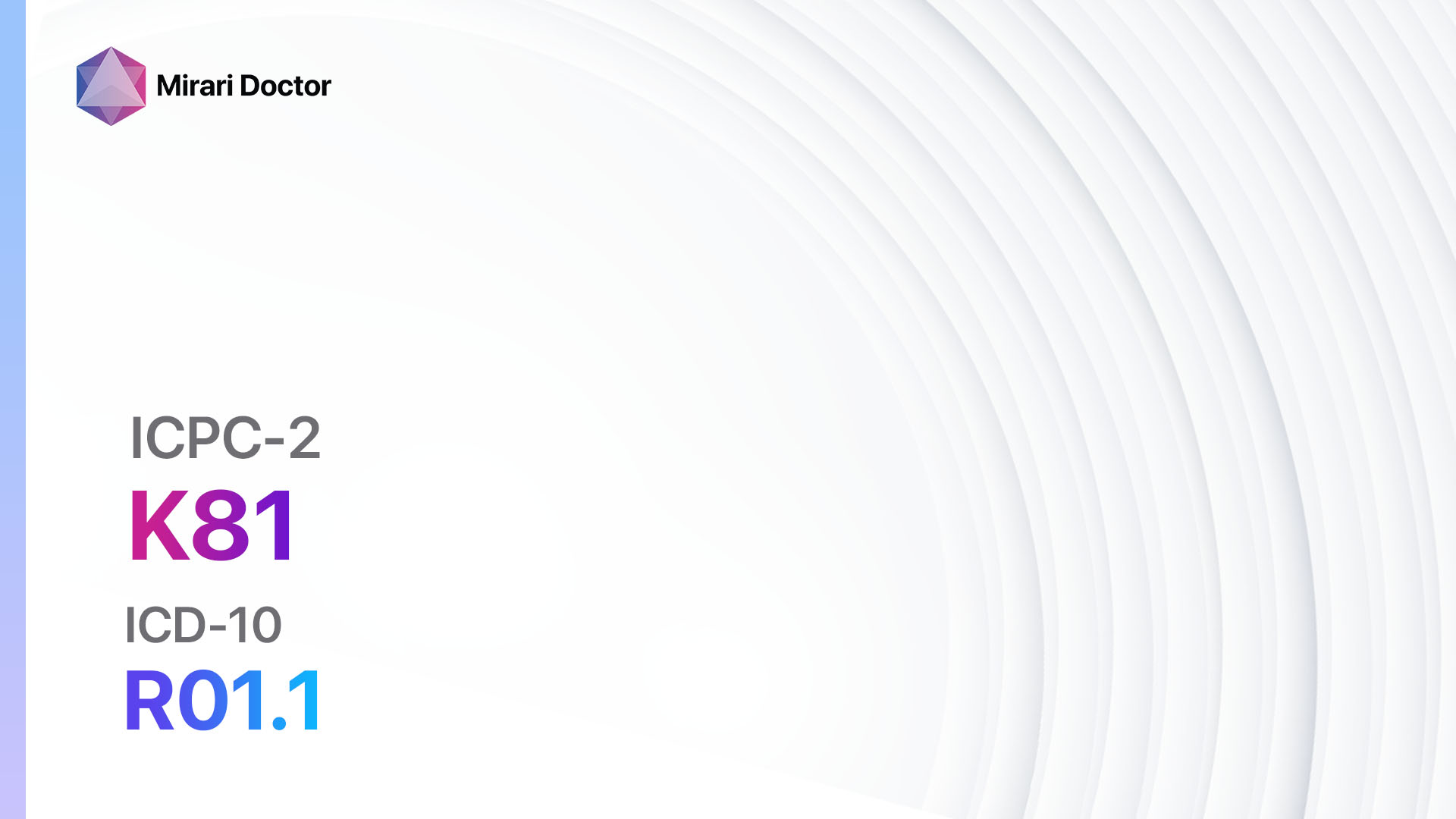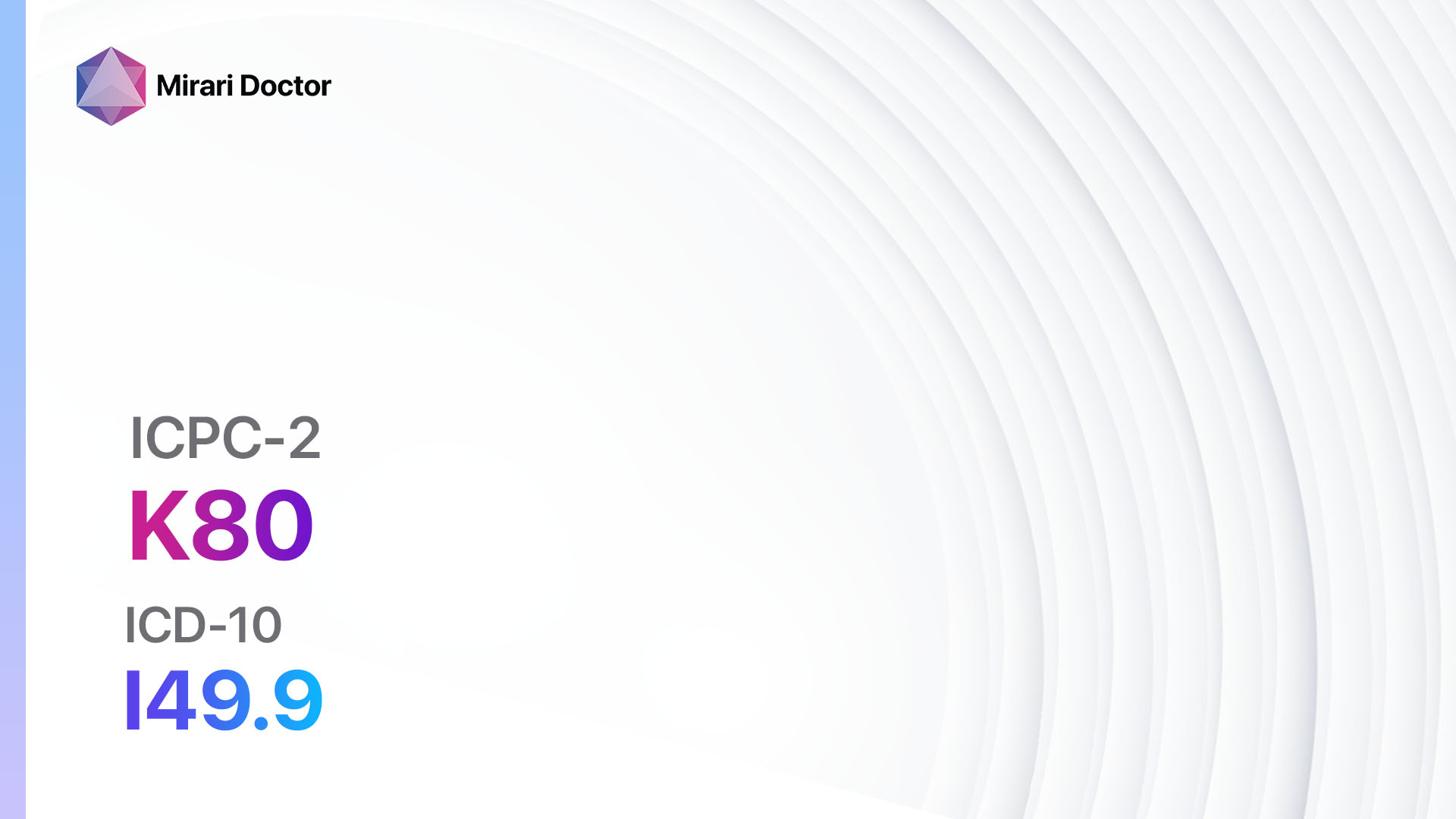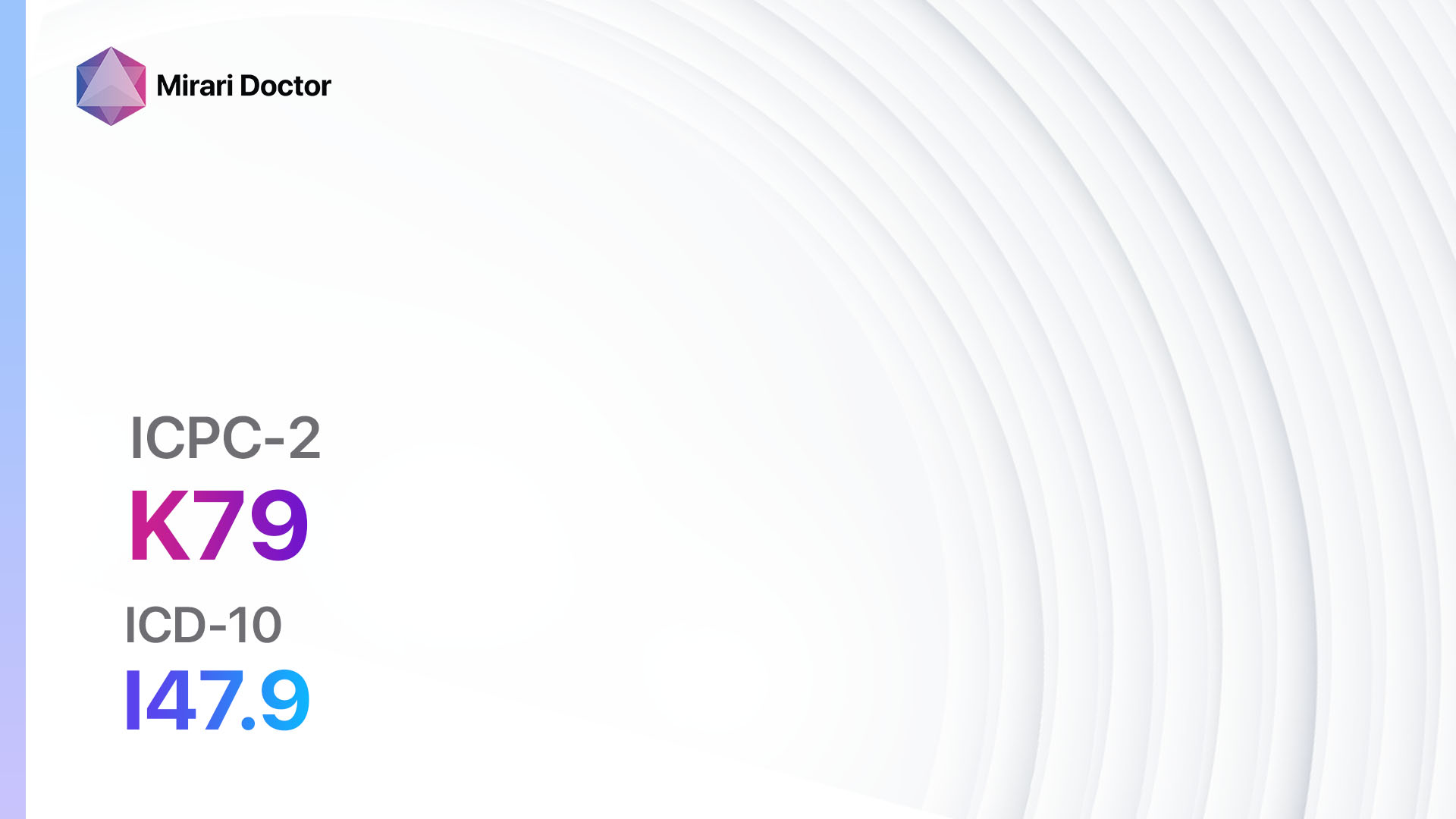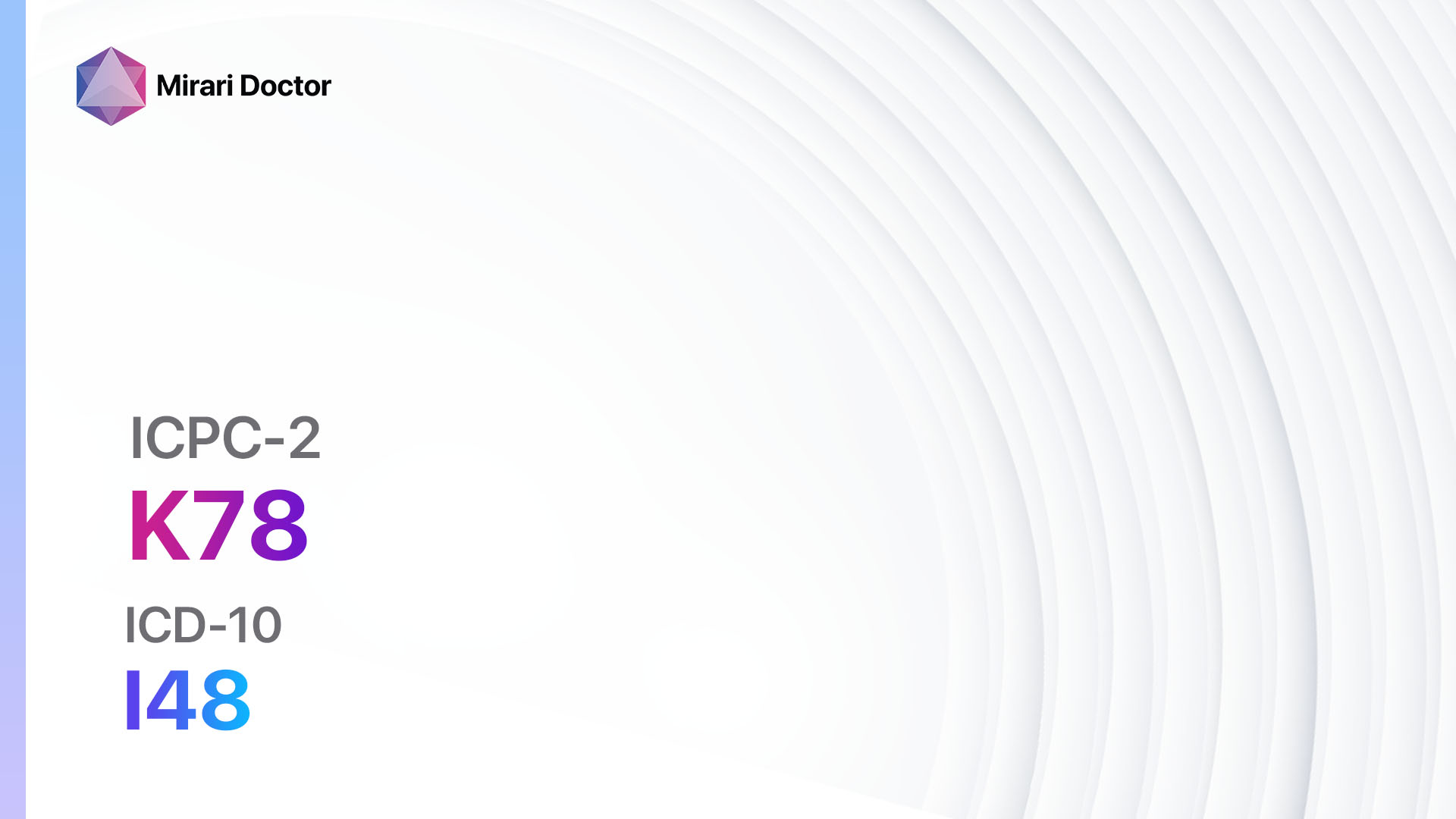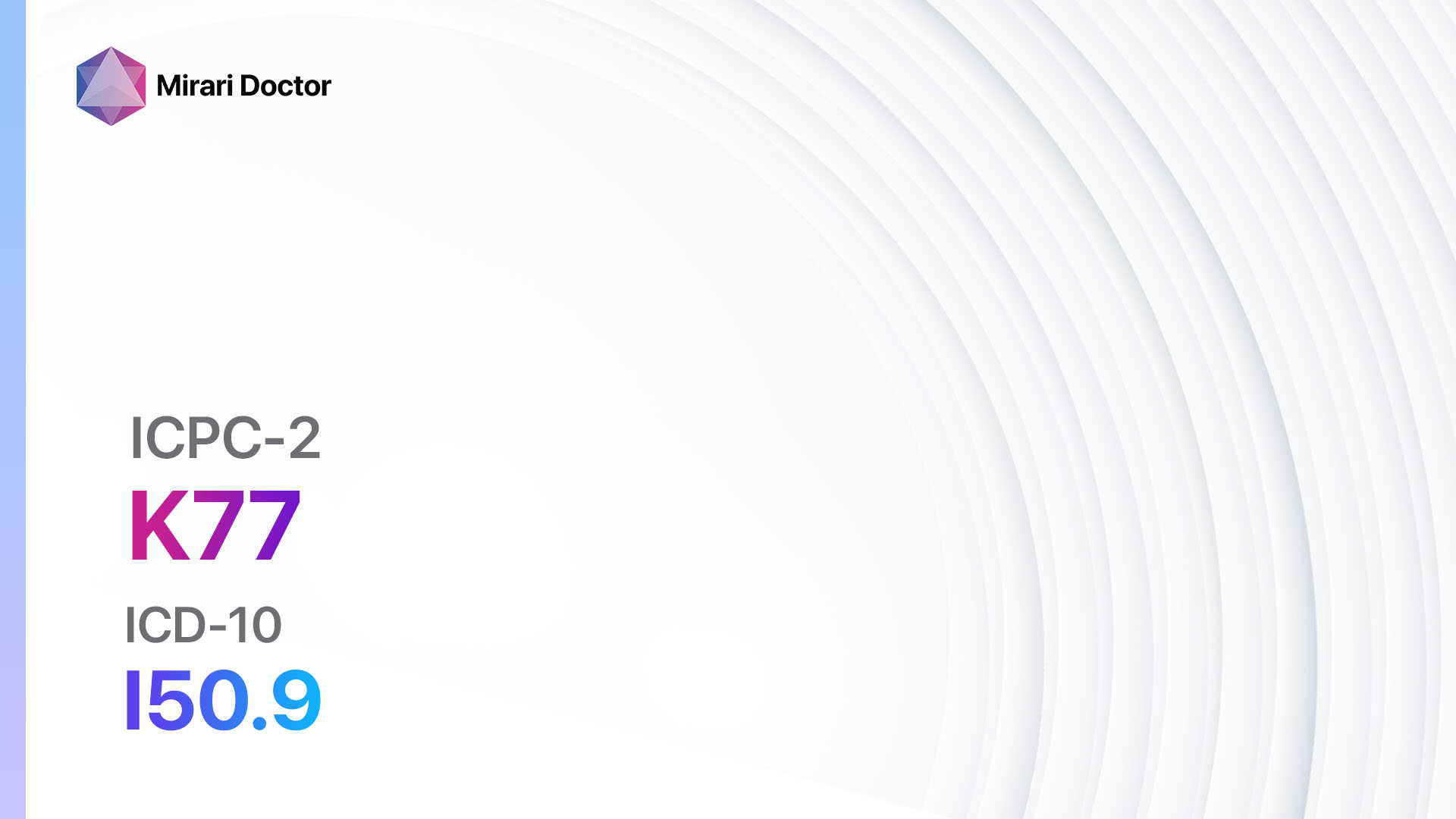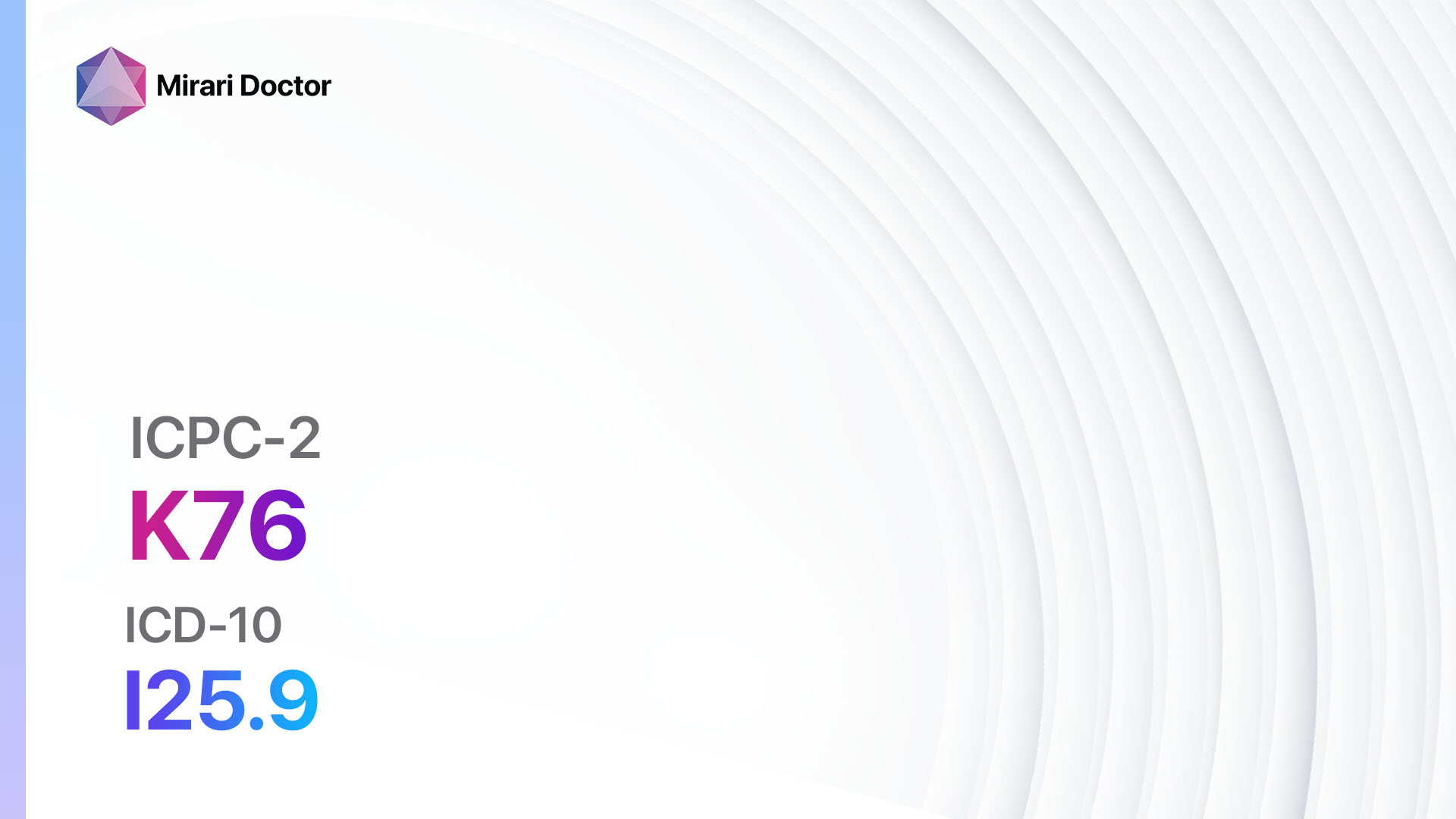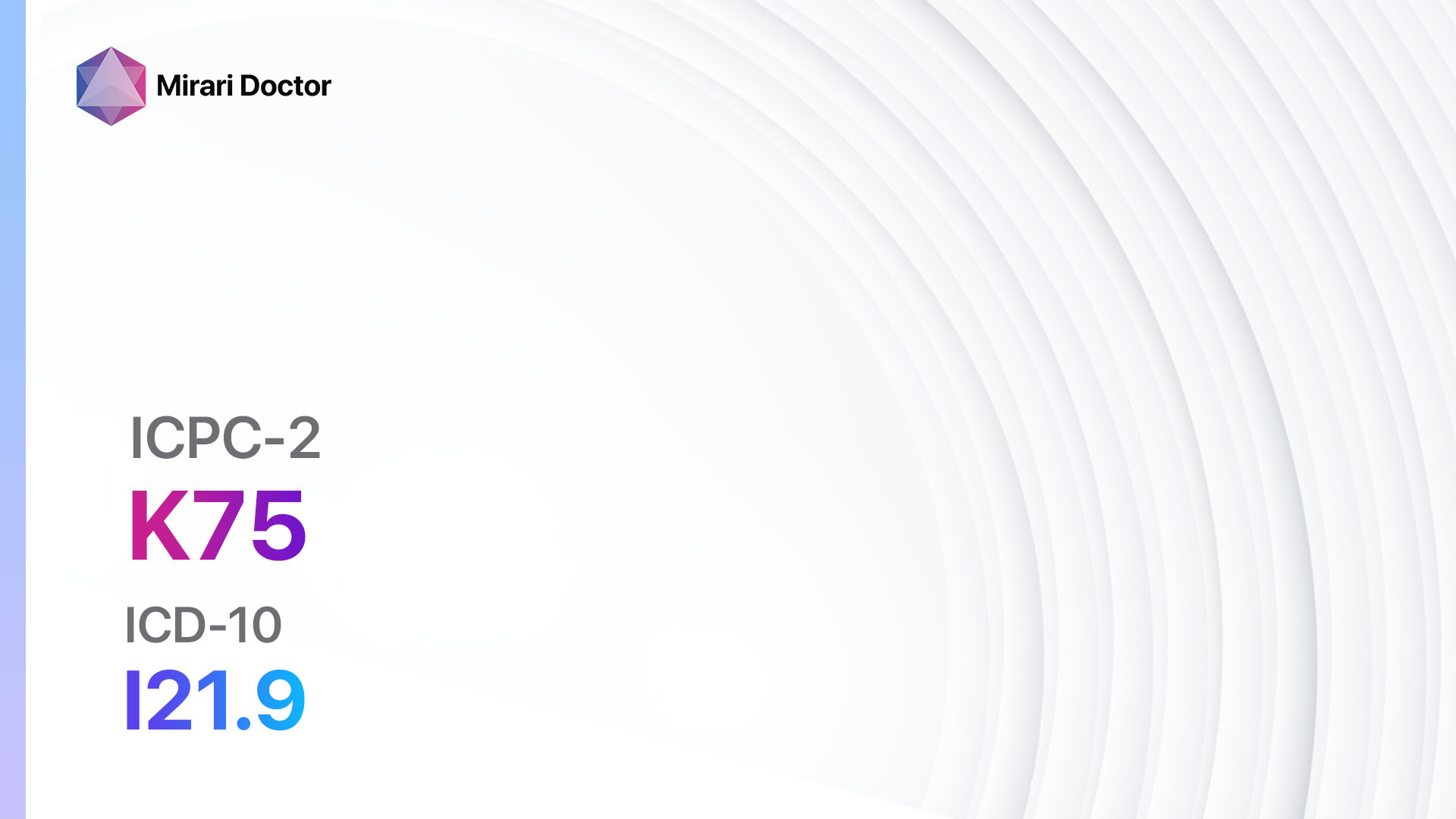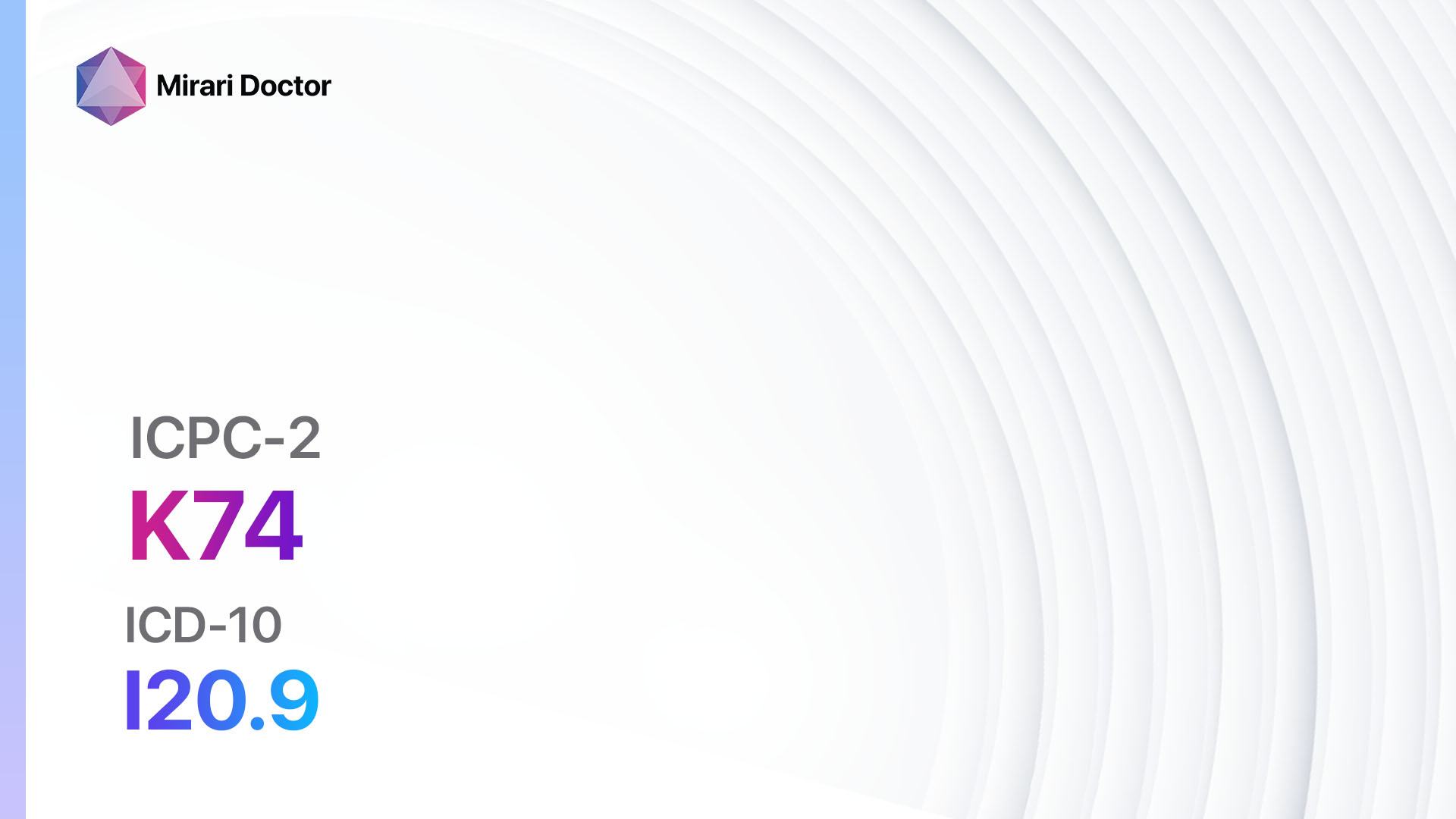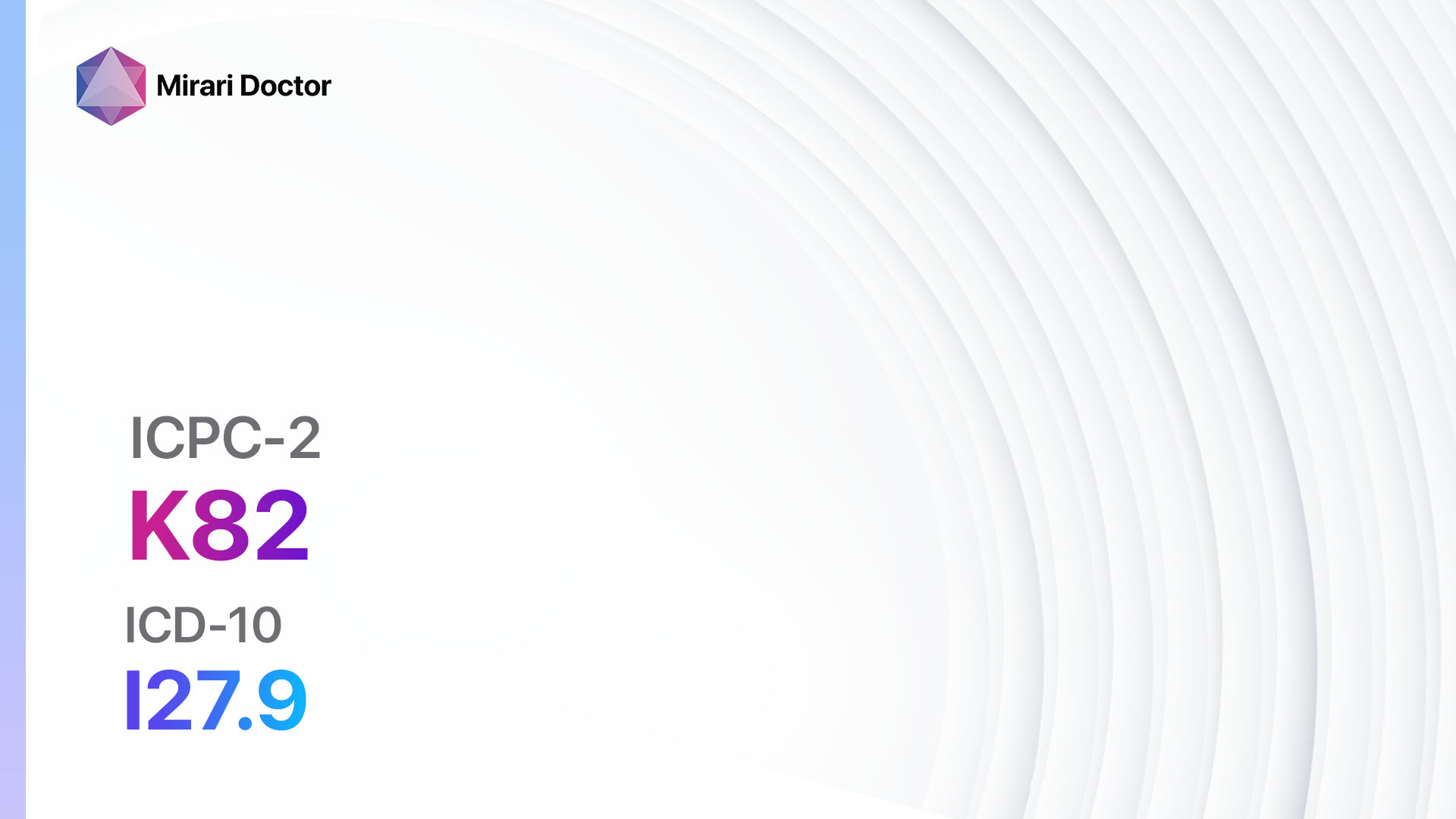
Introduction
Pulmonary heart disease, also known as cor pulmonale, is a condition characterized by enlargement and dysfunction of the right side of the heart due to lung disease or pulmonary hypertension[1][2]. It is a significant condition as it can lead to heart failure and other complications[3]. The aim of this guide is to provide a comprehensive overview of the symptoms, causes, diagnostic steps, possible interventions, and lifestyle interventions for pulmonary heart disease.
Codes
- ICPC-2 Code: K82 Pulmonary heart disease[4]
- ICD-10 Code: I27.9 Pulmonary heart disease, unspecified[5]
Symptoms
- Shortness of breath: Patients may experience difficulty breathing, especially during physical activity or while lying down[6].
- Fatigue: Patients may feel tired and lack energy[7].
- Swelling in the legs and ankles: Fluid retention can cause swelling in the lower extremities[8].
- Chest pain: Some patients may experience chest discomfort or pain[9].
- Cyanosis: Bluish discoloration of the lips, skin, or nails may occur in severe cases[10].
Causes
- Chronic obstructive pulmonary disease (COPD): Conditions such as emphysema and chronic bronchitis can lead to pulmonary heart disease.
- Pulmonary hypertension: High blood pressure in the arteries of the lungs can strain the right side of the heart.
- Pulmonary embolism: Blockage of the pulmonary arteries by blood clots can cause pulmonary heart disease.
- Lung diseases: Conditions such as interstitial lung disease, cystic fibrosis, and sleep apnea can contribute to the development of pulmonary heart disease.
Diagnostic Steps
Medical History
- Gather information about the patient’s risk factors, such as smoking history, exposure to environmental toxins, and family history of lung or heart disease.
- Inquire about symptoms related to pulmonary heart disease, such as shortness of breath, fatigue, and swelling in the legs and ankles.
- Assess the patient’s medical history, including any pre-existing lung or heart conditions.
Physical Examination
- Listen to the patient’s heart and lungs for abnormal sounds, such as a heart murmur or crackles in the lungs.
- Check for signs of fluid retention, such as swollen legs and ankles.
- Assess the patient’s oxygen saturation levels using a pulse oximeter.
Laboratory Tests
- Complete blood count (CBC): Evaluate for anemia or infection.
- Arterial blood gas (ABG) analysis: Measure oxygen and carbon dioxide levels in the blood.
- B-type natriuretic peptide (BNP) test: Assess the level of this hormone, which is elevated in heart failure.
- Pulmonary function tests: Measure lung function and assess for any obstructive or restrictive lung disease.
Diagnostic Imaging
- Chest X-ray: Evaluate the size and shape of the heart and look for signs of lung disease.
- Echocardiogram: Use ultrasound to assess the structure and function of the heart.
- CT scan or MRI: Provide detailed images of the heart and lungs, allowing for a more accurate diagnosis.
Other Tests
- Electrocardiogram (ECG): Record the electrical activity of the heart to assess for any abnormalities.
- Cardiac catheterization: Measure pressures in the heart and lungs to confirm the diagnosis and assess the severity of the condition.
Follow-up and Patient Education
- Schedule regular follow-up appointments to monitor the patient’s condition and adjust treatment as needed.
- Provide education on managing symptoms, such as avoiding triggers, taking medications as prescribed, and following a healthy lifestyle.
Possible Interventions
Traditional Interventions
Medications:
Top 5 drugs for Pulmonary heart disease:
- Diuretics (e.g., Furosemide, Spironolactone):
- Cost: Generic versions can be $3-$50/month.
- Contraindications: Allergy to sulfa drugs, anuria.
- Side effects: Frequent urination, electrolyte imbalances.
- Severe side effects: Dehydration, kidney damage.
- Drug interactions: Nonsteroidal anti-inflammatory drugs (NSAIDs), lithium.
- Warning: Regular monitoring of electrolytes and kidney function is required.
- Vasodilators (e.g., Sildenafil, Tadalafil):
- Cost: Generic versions can be $10-$100/month.
- Contraindications: Use of nitrates, severe liver or kidney disease.
- Side effects: Headache, flushing, low blood pressure.
- Severe side effects: Priapism (prolonged erection), sudden hearing loss.
- Drug interactions: Nitroglycerin, alpha-blockers.
- Warning: Caution should be exercised in patients with cardiovascular disease.
- Beta-blockers (e.g., Carvedilol, Metoprolol):
- Cost: Generic versions can be \<$30/month.
- Contraindications: Severe bradycardia, heart block.
- Side effects: Fatigue, dizziness, low blood pressure.
- Severe side effects: Worsening heart failure, bronchospasm.
- Drug interactions: Calcium channel blockers, insulin.
- Warning: Should not be abruptly stopped.
- Anticoagulants (e.g., Warfarin, Rivaroxaban):
- Cost: Generic versions can be $10-$100/month.
- Contraindications: Active bleeding, history of bleeding disorders.
- Side effects: Increased risk of bleeding.
- Severe side effects: Major bleeding, allergic reactions.
- Drug interactions: NSAIDs, other blood thinners.
- Warning: Regular monitoring of blood clotting parameters is required.
- Oxygen therapy:
- Cost: Varies depending on the delivery method (e.g., oxygen concentrator, portable oxygen tanks).
- Contraindications: None.
- Side effects: Dry or bloody nose, skin irritation.
- Severe side effects: Oxygen toxicity (with prolonged high-flow oxygen therapy).
- Drug interactions: None.
- Warning: Proper use and maintenance of oxygen equipment is essential.
Alternative Drugs:
- Prostacyclin analogs (e.g., Epoprostenol): Used in severe cases of pulmonary hypertension.
- Endothelin receptor antagonists (e.g., Bosentan): Block the action of endothelin, a substance that constricts blood vessels.
- Phosphodiesterase-5 inhibitors (e.g., Riociguat): Dilate blood vessels and improve exercise capacity.
Surgical Procedures:
- Lung transplantation: Considered in severe cases of pulmonary heart disease where other interventions have failed. Cost: $500,000 to $1,000,000.
- Pulmonary thromboendarterectomy: Surgical removal of blood clots from the pulmonary arteries. Cost: $100,000 to $200,000.
Alternative Interventions
- Acupuncture: May help improve blood flow and reduce symptoms. Cost: $60-$120 per session.
- Herbal supplements: Some herbs, such as hawthorn and garlic, may have potential benefits for cardiovascular health. Cost: Varies depending on the specific supplement.
- Breathing exercises: Techniques such as pursed-lip breathing and diaphragmatic breathing can help improve lung function and reduce shortness of breath. Cost: Free.
- Pulmonary rehabilitation: A comprehensive program that includes exercise, education, and support for patients with lung disease. Cost: Varies depending on the location and duration of the program.
Lifestyle Interventions
- Smoking cessation: Quitting smoking is crucial in managing pulmonary heart disease. Cost: Varies depending on the method used (e.g., nicotine replacement therapy, medications, counseling).
- Regular exercise: Engaging in regular physical activity can improve lung function and overall cardiovascular health. Cost: Varies depending on the chosen activity (e.g., gym membership, home exercise equipment).
- Healthy diet: Following a balanced diet rich in fruits, vegetables, whole grains, and lean proteins can support heart and lung health. Cost: Varies depending on individual food choices.
- Weight management: Maintaining a healthy weight can reduce the strain on the heart and lungs. Cost: Varies depending on the chosen weight loss method (e.g., diet programs, gym membership).
- Stress management: Techniques such as meditation, yoga, and deep breathing exercises can help reduce stress and improve overall well-being. Cost: Varies depending on the chosen method (e.g., self-guided, classes).
It is important to note that the cost ranges provided are approximate and may vary depending on the location and availability of the interventions. It is recommended to consult with healthcare professionals for personalized treatment options and cost estimates.
Mirari Cold Plasma Alternative Intervention
Understanding Mirari Cold Plasma
- Safe and Non-Invasive Treatment: Mirari Cold Plasma is a safe and non-invasive treatment option for various skin conditions. It does not require incisions, minimizing the risk of scarring, bleeding, or tissue damage.
- Efficient Extraction of Foreign Bodies: Mirari Cold Plasma facilitates the removal of foreign bodies from the skin by degrading and dissociating organic matter, allowing easier access and extraction.
- Pain Reduction and Comfort: Mirari Cold Plasma has a local analgesic effect, providing pain relief during the treatment, making it more comfortable for the patient.
- Reduced Risk of Infection: Mirari Cold Plasma has antimicrobial properties, effectively killing bacteria and reducing the risk of infection.
- Accelerated Healing and Minimal Scarring: Mirari Cold Plasma stimulates wound healing and tissue regeneration, reducing healing time and minimizing the formation of scars.
Mirari Cold Plasma Prescription
Video instructions for using Mirari Cold Plasma Device – K82 Pulmonary heart disease (ICD-10:I27.9)
| Mild | Moderate | Severe |
| Mode setting: 1 (Infection) Location: 5 (Lungs) Morning: 15 minutes, Evening: 15 minutes | Mode setting: 1 (Infection) Location: 5 (Lungs) Morning: 30 minutes, Lunch: 30 minutes, Evening: 30 minutes | Mode setting: 1 (Infection) Location: 5 (Lungs) Morning: 30 minutes, Lunch: 30 minutes, Evening: 30 minutes |
| Mode setting: 2 (Wound Healing) Location: 5 (Lungs) Morning: 15 minutes, Evening: 15 minutes | Mode setting: 2 (Wound Healing) Location:5 (Lungs) Morning: 30 minutes, Lunch: 30 minutes, Evening: 30 minutes | Mode setting: 2 (Wound Healing) Location: 5 (Lungs) Morning: 30 minutes, Lunch: 30 minutes, Evening: 30 minutes |
| Mode setting: 7 (Immunotherapy) Location: 1 (Sacrum) Morning: 15 minutes, Evening: 15 minutes | Mode setting: 7 (Immunotherapy) Location: 1 (Sacrum) Morning: 30 minutes, Lunch: 30 minutes, Evening: 30 minutes | Mode setting: 7 (Immunotherapy) Location: 1 (Sacrum) Morning: 30 minutes, Lunch: 30 minutes, Evening: 30 minutes |
| Mode setting:7 (Immunotherapy) Location:4 (Heart, Bile & Pancreas) Morning: 15 minutes, Evening: 15 minutes | Mode setting:7 (Immunotherapy) Location:4 (Heart, Bile & Pancreas) Morning: 30 minutes, Lunch: 30 minutes, Evening: 30 minutes | Mode setting:7 (Immunotherapy) Location:4 (Heart, Bile & Pancreas) Morning: 30 minutes, Lunch: 30 minutes, Evening: 30 minutes |
| Total Morning:60minutesapprox.$10USD, Evening:60minutesapprox.$10USD | Total Morning:120minutesapprox.$20USD, Lunch:120minutesapprox. $20 USD, Evening:120minutesapprox. $20 USD, | Total Morning:120minutesapprox.$20USD, Lunch:120minutesapprox. $20 USD, Evening:120minutesapprox. $20 USD, |
| Usualtreatmentfor7-60daysapprox.$140USD–$1200USD | Usualtreatmentfor6-8weeksapprox.$2,520USD–$3,360USD | Usualtreatmentfor3-6monthsapprox.$5,400USD–$10,800USD |
 |
|
Use the Mirari Cold Plasma device to treat Pulmonary heart disease effectively.
WARNING: MIRARI COLD PLASMA IS DESIGNED FOR THE HUMAN BODY WITHOUT ANY ARTIFICIAL OR THIRD PARTY PRODUCTS. USE OF OTHER PRODUCTS IN COMBINATION WITH MIRARI COLD PLASMA MAY CAUSE UNPREDICTABLE EFFECTS, HARM OR INJURY. PLEASE CONSULT A MEDICAL PROFESSIONAL BEFORE COMBINING ANY OTHER PRODUCTS WITH USE OF MIRARI.
Step 1: Cleanse the Skin
- Start by cleaning the affected area of the skin with a gentle cleanser or mild soap and water. Gently pat the area dry with a clean towel.
Step 2: Prepare the Mirari Cold Plasma device
- Ensure that the Mirari Cold Plasma device is fully charged or has fresh batteries as per the manufacturer’s instructions. Make sure the device is clean and in good working condition.
- Switch on the Mirari device using the power button or by following the specific instructions provided with the device.
- Some Mirari devices may have adjustable settings for intensity or treatment duration. Follow the manufacturer’s instructions to select the appropriate settings based on your needs and the recommended guidelines.
Step 3: Apply the Device
- Place the Mirari device in direct contact with the affected area of the skin. Gently glide or hold the device over the skin surface, ensuring even coverage of the area experiencing.
- Slowly move the Mirari device in a circular motion or follow a specific pattern as indicated in the user manual. This helps ensure thorough treatment coverage.
Step 4: Monitor and Assess:
- Keep track of your progress and evaluate the effectiveness of the Mirari device in managing your Pulmonary heart disease. If you have any concerns or notice any adverse reactions, consult with your health care professional.
Note
This guide is for informational purposes only and should not replace the advice of a medical professional. Always consult with your healthcare provider or a qualified medical professional for personal advice, diagnosis, or treatment. Do not solely rely on the information presented here for decisions about your health. Use of this information is at your own risk. The authors of this guide, nor any associated entities or platforms, are not responsible for any potential adverse effects or outcomes based on the content.
Mirari Cold Plasma System Disclaimer
- Purpose: The Mirari Cold Plasma System is a Class 2 medical device designed for use by trained healthcare professionals. It is registered for use in Thailand and Vietnam. It is not intended for use outside of these locations.
- Informational Use: The content and information provided with the device are for educational and informational purposes only. They are not a substitute for professional medical advice or care.
- Variable Outcomes: While the device is approved for specific uses, individual outcomes can differ. We do not assert or guarantee specific medical outcomes.
- Consultation: Prior to utilizing the device or making decisions based on its content, it is essential to consult with a Certified Mirari Tele-Therapist and your medical healthcare provider regarding specific protocols.
- Liability: By using this device, users are acknowledging and accepting all potential risks. Neither the manufacturer nor the distributor will be held accountable for any adverse reactions, injuries, or damages stemming from its use.
- Geographical Availability: This device has received approval for designated purposes by the Thai and Vietnam FDA. As of now, outside of Thailand and Vietnam, the Mirari Cold Plasma System is not available for purchase or use.
References
- Grünig, E., & Peacock, A. J. (2015). Imaging the heart in pulmonary hypertension: an update. European Respiratory Review, 24(138), 653-664.
- Taylor, W. E. (1984). Pathology of pulmonary heart disease. In Pulmonary Heart Disease (pp. 43-112). Springer, Boston, MA.
- Cascino, T., & Humbert, M. (2018). Pathophysiology of pulmonary arterial hypertension. In Pulmonary Hypertension (pp. 31-44). Springer, Cham.
- Jin, H., Kim, J. Y., Seo, Y., Choi, Y. J., Kang, S. H., & Kim, Y. (2022). Comparison between the International Classification of Primary Care-2 and the International Classification of Diseases-10 in primary care settings. BMJ open, 12(10), e048727.
- ICD10data.com. (2024). 2024 ICD-10-CM Diagnosis Code I27.9: Pulmonary heart disease, unspecified.
- Stringham, R., & Shah, N. R. (2010). Pulmonary arterial hypertension: an update on diagnosis and treatment. American family physician, 82(4), 370-377.
- Rubin, L. J. (2004). Diagnosis and management of pulmonary arterial hypertension: ACCP evidence-based clinical practice guidelines. Chest, 126(1), 7S-10S.
- King, M., Kingery, J., & Casey, B. (2012). Diagnosis and evaluation of heart failure. American family physician, 85(12), 1161-1168.
- McLaughlin, V. V., Archer, S. L., Badesch, D. B., Barst, R. J., Farber, H. W., Lindner, J. R., … & Varga, J. (2009). ACCF/AHA 2009 expert consensus document on pulmonary hypertension: a report of the American College of Cardiology Foundation Task Force on expert consensus documents and the American Heart Association developed in collaboration with the American College of Chest Physicians; American Thoracic Society, Inc.; and the Pulmonary Hypertension Association. Journal of the American College of Cardiology, 53(17), 1573-1619.
- Voelkel, N. F., Quaife, R. A., Leinwand, L. A., Barst, R. J., McGoon, M. D., Meldrum, D. R., … & Gail, D. B. (2006). Right ventricular function and failure: report of a National Heart, Lung, and Blood Institute working group on cellular and molecular mechanisms of right heart failure. Circulation, 114(17), 1883-1891.
Related articles
Made in USA


